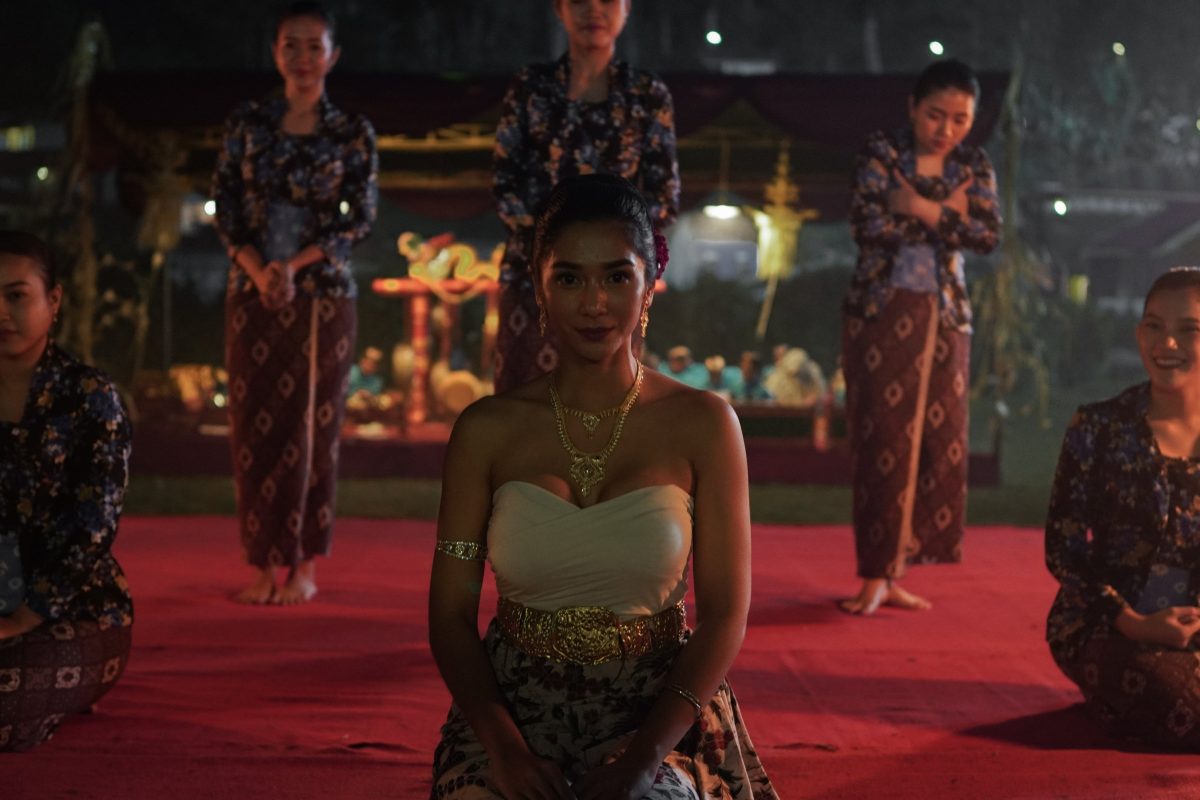“The Last 7 Days” (Original title: Sebelum 7 Hari, 2025) is a haunting feature-length adaptation of the acclaimed short film of the same name. Rooted in Javanese spiritual tradition, which holds that a soul lingers for seven days after death, the story unfolds with eerie reverence and creeping dread.
As Anggun, the ailing matriarch of a fractured family, lies on her deathbed, her estranged children, Tari and Kadar, are reluctantly summoned back to their ancestral home. It is here, amidst the thick air of unresolved memories and unspoken regrets, that Anggun meets her grandchildren, Hanif and Bian, for the very first time.
What begins as a mournful reunion quickly descends into a waking nightmare. The family’s return seems to awaken something ancient and malevolent. Mysterious rituals, whispered curses, and spectral figures in masks begin to blur the line between the living and the dead.
As the days pass, the remote, decaying house reveals its secrets—each more disturbing than the last—holding within its walls the true source of the family’s torment. With disorienting visions, creeping tension, and a sense of doom that tightens with each passing day, The Last 7 Days transforms grief into a gripping supernatural reckoning.
This article contains spoilers.
The Last 7 Days (Sebelum 7 Hari, 2025) Plot Summary & Movie Synopsis:
The film opens in 1987, with Anggun carrying her infant inside a stone cave that has a pool of water. Teary-eyed Anggun kills the baby and places her bloody hand inside the water, which pulls Anggun inside. Some women in masks start chanting and dancing around Anggun. The leader of the group pierces a needle straight through Anggun’s forehead. In 2024, the brother-sister duo, Hanif and Bian, run home from school. Outside their shop, they meet their uncle Kadar.
Once the kids go inside the house, Tari gives her brother Kadar money and says she can no longer afford to keep helping Kadar. Now, Kadar informs Tari that their mother, Anggun, is on her deathbed, so they need to be with Anggun. However, Tari has not forgiven Anggun. Still, Kadar convinces Tari to visit their mother.
Why is Bian terrified of Anggun?
On the way to the house, Kadar gets a message asking him to repay his debts. The house is in a remote place, and Hanif is amused to see how big the house is. Inside, Hanif and Bian see a painting of Anggun when she was young and are in awe.
However, they realise Anggun must look old now. Suddenly, the family hears a jingle, so caretaker Mbok Yati rushes to Anggun’s room and plays some music that always calms Anggun. In the room, Hanif is introduced first to Anggun. When Bian holds Anggun’s hand, she grabs Bian, scaring everyone. Later, everyone is shocked to see Anggun as she looks younger than Tari, even though she is seventy years old.
The kids are asked to stay in Tari’s old room. Inside that room, Hanif sits on Anggun’s rocking chair. Meanwhile, Kadar finds a certificate of ownership, some cash, and a mask in one of the room cupboards. That night, Kadar enquires about Anggun’s illness and learns that the doctors have given up as they could not diagnose Anggun. So, Mbok Yati calls a shaman, Ki Husein, who thinks there is a problem.
Hearing this, Tari is annoyed as she believes they need to find another doctor and not a shaman. The next day, Hanif loses his toy, and Bian finds it under Anggun’s bed. When Bian takes it out, Anggun starts shaking and falls on Bian from her bed. After Kadar puts Anggun back, she projectile vomits on Kadar’s face.
What incidents are scaring the family?
The family calls Ki Husein to find out the problem and help Anggun. Ki Husein performs a ritual and takes out seven charm needles from Anggun. The minute Ki Husein does that, Anggun is almost reduced to bones, killing her instantly. The charm needles are the reason why Anggun could not die a natural death. Before leaving, Ki Husein gives the charm needles to Kadar to keep them until the day of burial.
According to Javanese belief, the spirit lingers for seven days. So Ki Husein asks the family to bury Anggun in that cave’s water along with the needles on the seventh day. Additionally, Anggun needs to be cleaned and wrapped in a Jarik cloth (a type of cloth made with the batik technique that usually has some pattern). While washing Anggun, Tari hears an echo of someone asking her to leave now.
That night, Tari prays beside Anggun’s body when she starts to see things. At the same time, Bian wakes up to an empty rocking chair moving. Even in fear, Bian tries to go under the blanket to sleep, but gets scared as she sees Anggun next to her. On the second day of the ritual, Hanif is live on social media, showing his followers the house and the pool. When Hanif hears Bian calling out for him, Hanif hides inside the cupboard in Kadar’s room.
Hanif sees someone wearing a mask there, so Hanif jumps out of the closet in fear. Under a table, Hanif sees the mask and takes it. That night, Kadar is worried about his debts when he hears some women chanting. When Kadar comes close to Anggun’s body, he sees women praying, but when Kadar switches the light on, they disappear. On the third day, Hanif tries on the mask and sees Anggun in the mirror.
Why does Tari bury Anggun on the sixth day?

That night, Hanif has a disturbed sleep as he sees Bian rocking on the chair. A while later, Bian sits next to Hanif. When Hanif opens his eyes, he sees a scary-looking Bian. So, Hanif rushes to Tari and complains about Bian. However, inside the room, Bian is fast asleep. Since Hanif is scared, Tari sleeps with the kids. Now, Tari finds the mask and questions Hanif, and he reveals that he sees Anggun when Hanif wears the mask.
On the fourth day, since the place is scary, Tari decides to buy bus tickets to leave as soon as the rituals are done. However, the kids are fast asleep, so Kadar offers to watch them. As soon as Tari leaves, Kadar goes out, gets drunk, and sleeps with a girl. When the kids wake up, they see Anggun’s corpse erect, scaring them. Thankfully, Tari arrives in time.
On the fifth day, Kadar wakes up naked in a graveyard. Kadar rushes home and faces an angry Tari. That night, Tari wakes up and sees that Bian is not in bed. When Tari gets out, she sees some masked women, and one among them is Bian. So, Tari tries to push these women away, but they start chanting, asking to keep the promise.
On the sixth day, Tari burns the mask. Tired of the hauntings, Tari decides to bury Anggun in the ground before the end of the ritual days. After finishing the rituals, the family comes home to find Anggun’s body inside the house. As the family sleeps, Kadar wakes up to deal with a masked woman who throws Kadar into a pool.
The Last 7 Days (Sebelum 7 Hari, 2025) Movie Ending Explained:
On the seventh day, the family and Ki Husein wake Kadar up. They now enter the cave and bury Anggun inside the water with the needles. That night, Tari puts on the mask and learns of what happened through Anggun from the other side of the mirror. The child Anggun killed was her own, and it was the charm curse that kept her alive.
The reason Anggun abandoned Kadar and Tari when they were kids was that if they stayed in that house, they would succumb to the curse eventually. That’s why Anggun asked them never to return to the house. To fulfil this, Kadar would be a human sacrifice, and this would continue with Tari’s children as well. To break the curse, the needles need to be returned, and the mask burned. Furthermore, Anggun teaches Tari a chant to help with breaking the curse.
Tari realises Kadar did not leave the original needles inside the water, as he wanted to sell and make money out of them. Just as Tari confronts Kadar, Hanif and Bian are levitating, stuck to the roof. Suddenly, they are pushed down and pulled outside the house. While Kadar and Tari try to stop Bian from flying away, Hanif is taken by some force. The only way to bring back Hanif is to break the curse. So Kadar and Tari head to the cave, and a voice tells them that Anggun made a promise, so they are taking what they are owed.
Kadar volunteers to be taken instead of Hanif. Now, Hanif’s body comes out of the water. As they rescue Hanif, Kadar is surrounded by the masked women. Tari breaks the mask, which also breaks the leader’s mask. This makes the group disappear. Relieved, Kadar walks towards Tari, but the leader pulls Kadar deep into the water. The family leaves the house immediately. On the hundredth day, inside Anggun’s room, the leader is chanting and performing a ritual.
At its core, the film explores the Javanese belief in the seven-day ritual following death—a period during which the soul is thought to linger in the earthly realm. Throughout these seven days, the unsettling apparitions and recurring presence of Anggun symbolize her spirit’s continued existence among the living. The ancestral house itself appears to function as a conduit between the physical world and the supernatural, blurring the line between what is real and what lies beyond.
Layered beneath the surface is a disturbing thread of human sacrifice. While the exact motive behind Anggun’s decision to kill her first child remains ambiguous, the film hints at a desperate bargain—perhaps to gain wealth or preserve youth. Yet this exchange feels incomplete, as neither beauty nor prosperity seems to follow. Instead, it is implied that Anggun may have forged a dark pact, offering up her bloodline to a hidden, ritualistic cult in return for power or protection.
The ending leaves a lingering chill, suggesting the curse has not been broken. In the final moments, the mysterious leader of the cult remains inside the house—an ominous presence that signals the evil still festers, waiting for the next soul to claim.

![Triple Frontier [2019] Review: Interesting Premise, Uneven Execution.](https://79468c92.delivery.rocketcdn.me/wp-content/uploads/2019/03/triple-frontier-screenshot-1-768x360.jpg)


![The Endless Trench [2019] Netflix Review – An Incredible Drama on the Living Ghosts of Francoist Spain](https://79468c92.delivery.rocketcdn.me/wp-content/uploads/2020/04/The-Endless-Trench-2019-768x433.jpg)

